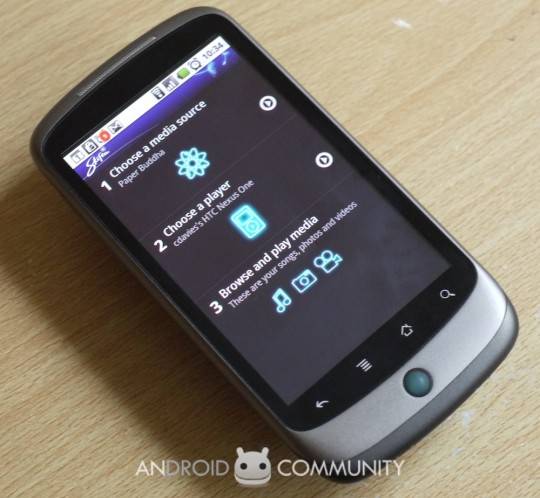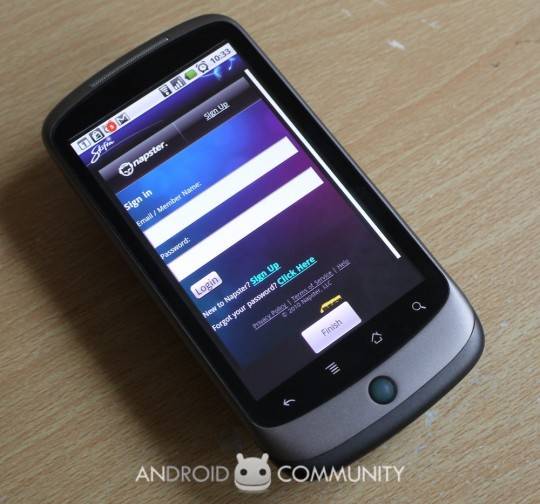
We’ve been covering Qualcomm’s Skifta project since almost the very beginning, from when the DLNA streaming media system was a simple 2009 side-project in the chipset company’s labs, to its status as a legitimate standalone product with an eye on potential revenue streams. Android Community has had early access to the latest version of Skifta, hitting the Android Market today, to see whether a free app can really replace expensive media streaming systems around the home and office.
Skifta build 68 does everything we’re already familiar with from the app, so you get access to local media sources – such as your phone, NAS, computers sharing media and other devices – as well as streaming radio content, which can be squirted to a DLNA-compliant TV, WiFi radio or other device and controlled from your Android phone. A free download, it uses straightforward media plugins to add extra internet content; as for playback, if you have an internet-connected TV (or a DLNA-supporting streamer) then you’re all set.

As ever, as long as you have the bandwidth, it all works surprisingly well. The Skifta UI has been polished since the early days, with a three-step process of picking a source – audio, video or images, including Facebook and Picasa photos – then a playback device, and finally choosing which media you’d like to play. The new version adds in support for premium channels, like Napster; if you have a Napster account, you can log in and access the service’s 10m+ streaming tracks.

There’s also new control over playback, to take into account the fact that not all media players are created equal. Given that many users have drives full of video and audio using different codecs, Skifta now allows you to choose which media player app on your phone you want to use to render the content. We loaded up vPlayer and Rock Player, and could choose between them in a simple Android dialog box. It means that files not natively supported by the Android media player can now often be played using a third-party player, and hugely extends the use of Skifta.
We caught up with Skifta’s director of marketing, Gary Brotman, at MWC 2011 last week, and talked to him about the future of the app and the growing Skifta ecosystem. With a long background in digital music – Brotman is actually behind one of the streaming radio channels featured in Skifta, Paper Buddha – he’s unsurprisingly enthusiastic about the potential of the app, particularly when it comes to partnerships with other media sources. Napster – as added in build 68 – is just the start of it; Brotman is also keen to work with other subscription-based music services, such as Spotify.
“It’s less about owning music, today, and more about having access to it” he told us, suggesting that while people have historically built up huge stacks of CDs and records, and then gone on to amass collections of MP3s, the focus now is shifting away from ownership and more to ubiquity. Part of that is the increase in connectivity options, like 3G/4G on mobile devices and faster WiFi networks in homes and offices. “Previously, you had what content you could carry or had loaded up before you left” Brotman explained.
As for making Qualcomm some money, Brotman is cautious of the usual ways Android apps are monetized. Although adverts are the obvious strategy – either AdWords in the app itself, or even audio or video promotions interspersed with the streamed content – he’s wary of negatively impacting the user experience, especially when it comes to mining users’ media catalogs for context-aware ads.

Instead, the Skifta team is looking for more roundabout ways of commercialising the software, perhaps through affiliate links to download music from Amazon or other vendors. If you hear a track you like on a streaming radio station, Skifta could offer a one-click way of purchasing that music, with Qualcomm taking a slice of the proceeds. Alternatively, if more premium channels – such as Spotify – get onboard, Skifta could take a tithe of their subscription revenue too.
Of course, there’s always the potential for Skifta to evolve into a paid version, or perhaps split into free and premium, though for now the app remains a free download. You can find the updated build 68 in the Android Market; don’t forget to let us know how you get on in the comments.










I find most Qualcomm products to be amazing and useful, but I have found the Android release to be lacking. I have been using the Remote Access app from my employer, DISH Network, to stream live TV, on demand content, and all of my DVR recordings to my android. I believe Qualcomm has a lot to catch up to in the Android market, but have high hopes for them.
Sorry, James. Expect your hopes to be dashed. Skifta is headed the same direction as Qualcomm’s FLO-TV. Qualcomm can engineer intriguing niche products, but they have zero idea how to commercialize them, build a distribution infrastructure, and translate great ideas into real business outcomes. Qualcomm simply does not understand or embrace consumer marketing.
You seem to know.
i think the skifta is veru useful ,first i don’t know how to use,then i found an example about it(http://videos-phone.net/how-to-use-android-phone-to-control-wd-tv-play-video/,It's so easy